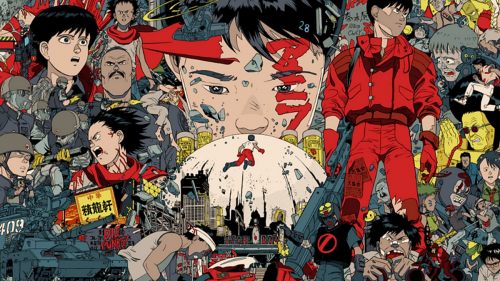30 Years Later, Science Fiction Still Owes A Debt To AKIRA
If you’ve watched a sci-fi film made after 1988, you’ve probably interacted with something inspired by Akira. Katsuhiro Otomo’s highly influential anime is often on the minds of Western filmmakers delving into sci-fi, and threads of Akira’s influence can be found in all aspects of popular culture today - you’ll see the superpowered problem child narrative in films like Looper and Chronicle; you’ll hear the heavy drums and gasps of the film’s loud and abrasive score in Kanye West’s "Black Skinhead" (Ye is known to be a huge fan).
It’s another lasting symbol of cultural exchange between the East and the West, along with works like Seven Samurai and Yojimbo - films that borrowed from Westerns, which then became quoted by Westerns. Otomo cited inspiration from American sci-fi films like Blade Runner, Videodrome, and 2001, and you can feel it. In addition to Neo Tokyo’s expansion of Scott’s future LA, there are shades of 2001’s "Jupiter and Beyond the Infinite" section when Kaneda disappears into the new universe of the third act, passing through childhood memories on the way. And then there’s that disgusting, giant mutant baby, which I hope made Cronenberg proud.
After its silent opening that shows us annihilation, we’re dropped into a Blade Runner-esque cityscape of neon lights - gargantuan, elegant skyscrapers towering over a trash-strewn underbelly. A gang of bikers, lead by the protagonist Shotaro Kaneda, race through abandoned tunnels and motorways, their bikes leaving trails of light behind them. One of the first things we see is a protest that comes to a violent end with the intervention of the police, future elegance contrasting with familiar oppression. Much like Ridley Scott’s dystopian vision of the future, both the city skylines and the streets below are peppered with adverts for real brands (a constant of future dystopias: Coca-Cola still exists). The film starts small, then goes really big, as Kaneda’s childhood friend Tetsuo is kidnapped and experimented on by the government.
Painstakingly animated by hand, the care that went into Akira can be seen in every frame, each bursting with an unfathomable range of colour. There’s 327 shades in the film, 50 of which were invented for it. Unlike many anime films both at the time and even today, the animation of each character was tailored to the pre-recorded dialogue. Otomo’s ambition also crosses over to the narrative, mixing kinetic, intense action with a paranoid plot that explodes outwards from a depiction of restless youth in revolt to apocalyptic destruction. From the opening moments, it’s clear that the film is driven by a fascination with the atom bomb (they don’t hide it either – the government scientist looks like Einstein) and the stuff that makes us, holding the power both to destroy and create. Considering this, its closest American companion in animation might actually be Brad Bird’s The Iron Giant, a film born from the concept "what if a WMD didn’t want to be a WMD" – in Akira, the question is “what if a WMD was an unstable teenager”.
From theme to even just little stylistic flourishes, the film’s influence lives on. One of the more celebrated moments in last year’s Star Wars: The Last Jedi, the light speed crash, has elements of Akira in there, specifically the silent nuclear explosion from the opening. Shades of Neo Tokyo and elements of Tetsuo’s arc can also be seen in Rian Johnson’s Looper. It’s even been cited as an influence on the prequel trilogy too; the gargantuan skyscrapers of Corusant, home to the Jedi HQ, owe more than a little to Neo Tokyo.
Not only are its cyberpunk cityscapes oft replicated, but it can also stake a claim as being one of the forefathers of telekinetic problem child narratives, give or take a Carrie: Midnight Special, Chronicle, hell, even Lucy - a film that begins with the protagonist being kidnapped and turned into a drug mule, and ends with her transcending humanity and mutating into a giant computer (it’s a weird movie).
Its arrival marked a tectonic shift that also affected the direction of American sci-fi itself, via films like The Matrix. The Wachowski Sisters’ seminal film has Otomo’s influence all over it, both in terms of its cyberpunk style, and perhaps also in the apocalyptic theme - The Matrix adopts Y2K paranoia instead of Akira's musing on the wrath of the atom bomb, but keeps the concerns with enlightenment, transformation and the next phase of the human race. Even the film’s famous "bullet time" sequences were inspired in part by Otomo. It wouldn’t be a stretch to say that it also fed into the Wachowski’s other works, with the futuristic cityscapes of Cloud Atlas or Speed Racer’s vivid use of colour and digital backgrounds. Akira's overwhelmingly positive reception in the States opened the anime floodgates for audiences in the West, and also for anime with more adult themes and content (e.g. Ghost in the Shell, Perfect Blue, Cowboy Bebop) all of which found immense popularity alongside shows aimed at younger audiences, like Naruto, Dragon Ball, or Pokemon.
Not unlike the giant mutant baby from the film’s third act, Akira’s tendrils of influence reach surprisingly far, so much so that I haven’t even mentioned that both Michael Jackson and Kanye West made music videos based on sequences from the movie. It’s become a text almost as revered as its predecessors, referred to in pretty much any film featuring a telekinetic child or future dystopia. The final act almost acts as a treatise on the film itself, a ground-shaking work that launched sci-fi into a new order, while reflecting on the past.



